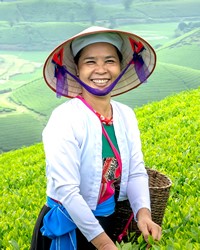Muong in Vietnam

Photo Source:
Copyrighted © 2025
Quang Nguyen Vinh - Shutterstock All rights reserved. Used with permission |
Send Joshua Project a map of this people group.
|
| People Name: | Muong |
| Country: | Vietnam |
| 10/40 Window: | Yes |
| Population: | 1,516,000 |
| World Population: | 1,516,000 |
| Primary Language: | Muong |
| Primary Religion: | Ethnic Religions |
| Christian Adherents: | 1.00 % |
| Evangelicals: | 0.02 % |
| Scripture: | Complete Bible |
| Ministry Resources: | Yes |
| Jesus Film: | Yes |
| Audio Recordings: | Yes |
| People Cluster: | Mon-Khmer |
| Affinity Bloc: | Southeast Asian Peoples |
| Progress Level: |
|
Introduction / History
The Muong inhabit the mountainous slopes of north central Vietnam, from the lower reaches of the Da River to the upper reaches of the Ma River. The Muong speak a Mon-Khmer language that is closely related to Vietnamese.
Prior to the Chinese conquest of the Red River delta region, the Vietnamese and the Muong formed a fairly unified group. While the forefathers of the Viet peoples migrated down the plains and became influenced by the Chinese, the Muong's ancestors stayed in the mountains, preserving their culture. Thus, the two groups developed independently. The Muong decisively rejected the cultural influence of the Chinese. Since communism took over Vietnam, the Muong have had more influence from the ethnic Vietnamese. Yet they retain their own language called Muong.
What Are Their Lives Like?
The Muong have an extraordinarily unified culture. One can pass through large areas of Muong territory without ever passing through the territory of another ethnic group. There is also a strong feeling of mutual aid within the Muong villages. Villagers willingly help one another with local projects and depend on each other for mutual support and help during times of trouble.
Farming is the foundation of the Muong economy, although gathering, fishing, hunting, raising livestock, and making handicrafts have also become very important. The farmers raise wet rice on terraced land, watered by small brooks. They also grow dry rice. Since productivity is low, the Muong also gather cinnamon and wood for trade. Many of their towns have become trading centers. For their meat supply they raise buffalos, pigs and chickens.
Muong villages generally consist of 10 to 25 households. They are usually situated on plateaus, or near water at higher altitudes (over 2,600 feet). They live in houses that are raised about six feet off the ground on wooden stilts. They are large, rectangular dwellings divided into separate rooms by shoulder-high bamboo screens. Each home has a verandah at its entrance. There they keep a bucket of water for washing their feet before entering the home.
They love art forms like lullabies, riddles, proverbs, folk tales and stories. Their favorite musical instruments include a flute, a two-stringed violin, a panpipe and especially the gong.
What Are Their Beliefs?
Most Moldovan Orthodox Christians belong to the Moldovan Orthodox Church, a branch of the Russian Orthodox Church. There are Evangelicals among them, and their numbers vary by country.
What Are Their Needs?
The Moldovan Orthodox Church needs a fresh move of the Holy Spirit. They need to center their love and devotion on Jesus Christ.
Prayer Points
Pray for a movement among Muong people toward Lord Jesus Christ.
Pray for Muong culture to be renewed and enhanced by a work of the Holy Spirit into a God-centered and God-honoring mold.
Pray for the Holy Spirit to move among Muong family and community leaders to seek his face and enjoy his blessings.
Pray for the Lord to thrust out workers who will be compelled to nurture a movement to Christ among the Muong people.
Pray that soon the Muong people will have faith that will lead them to live honorable lives that will draw others to the savior.